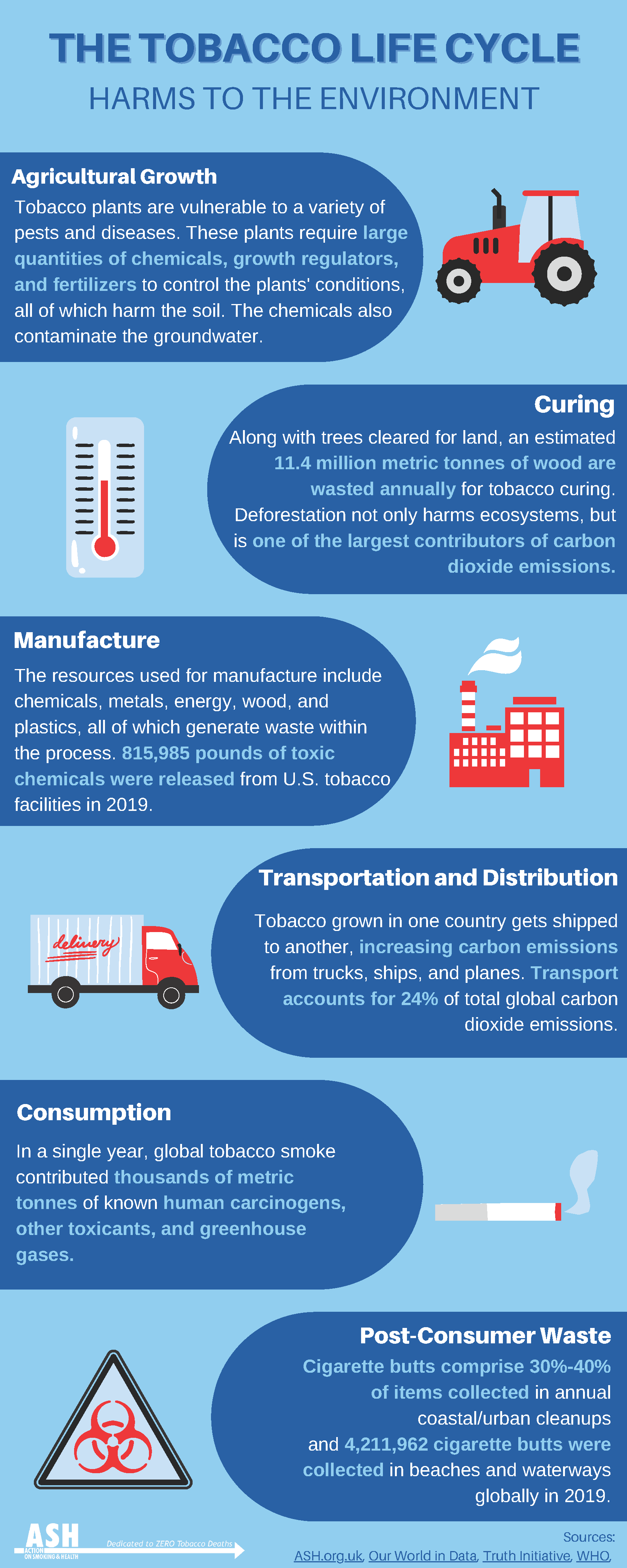Author: Maia Murphey, ASH Program and Communications Intern
From manufacture to consumption, tobacco products are not only a dangerous public health concern, but also an environmental concern. In addition to over 8 million human lives lost every year to the tobacco industry, we also lose 600 million trees, 200,000 hectares of land, and 22 billion tonnes of water, as well as 84 million tonnes of carbon dioxide being released into the atmosphere (source).
Cigarette butts are the most littered item on earth. 75% of people who smoke report that they dispose of cigarettes on the ground, producing an estimated 1.69 billion pounds of cigarette butts as toxic trash each year (source). The toxic chemicals leach into the soil and pollute waterways, beaches, roadsides, sidewalks, and green spaces. Cigarette butts are toxic to children who may swallow them as well as animals that eat them and fish that get poisoned by contaminated water.

Tobacco companies try to place all the blame on users for cigarette butt pollution and waste. In the 1930’s, connections were being made over the increase in mortality rate of smokers and tobacco companies had to look for solutions. One of those fake “solutions” was cigarette filters, an attempt to make cigarettes seem safer. Cigarette butts are primarily made up of plastic filters that don’t biodegrade and don’t protect users from the deadly toxins in each cigarette. It takes at least nine months for a cigarette butt to degrade under optimal conditions (source).
And unfortunately, dropping cigarette butts is often referred to as the “last remaining acceptable form of littering.” A radical solution: ban cigarette filters altogether. Tobacco companies have been exploring biodegradable filters since the 1970’s, but haven’t made the switch because governments have not yet forced them to change production. Some tobacco companies have included reducing the amount of cigarette butts in the environment as part of their sustainability goals, but these industries not only create the waste in the first place, but they are now trying to cover that up through misleading public displays of eco-activism, also known as greenwashing.
“Greenwashing” refers to the practice used by controversial industries to market their goods and/or image as environmentally friendly. Tobacco companies attempt to divert public attention away from the environmental costs of their companies through corporate social responsibility programs and other marketing tactics. These companies are often seen marketing themselves as “Climate Leaders” with their position on rankings such as the Dow Jones Sustainability Index. Not only do these indexes misconstrue the definition of a “sustainable company,” but promoting oneself as an environmental steward this way is disingenuous. Rather than letting the largest transnational tobacco companies hold themselves to a high standard of sustainability, these companies should be held accountable for the long-term ecological harms their business causes.
The littering of tobacco products goes beyond cigarettes. Many popular e-cigarettes are pod-based with single-use plastic cartridges. Generating even more waste are disposable e-cigarettes, designed entirely for one-time use. E-cigarette waste has potentially more serious environmental effects than cigarette butts (source). E-cigarettes introduce plastic, nicotine salts, heavy metals, lead, mercury, and flammable lithium-ion batteries into the environment and these products won’t biodegrade even under severe conditions.
Almost half — 49.1% — of young people don’t know how to dispose of these devices and 46.9% of device owners say that the product they bought did not provide any disposal information such as where to send used batteries or empty pods (source). E-cigarette manufacturers do not provide guidance to consumers on how to dispose of used products. Once again, we see tobacco companies and e-cigarette manufacturers being the root of the problem by not only creating and distributing the product, but also by their lack of guidance to consumers on how to dispose of their devices.
In order to gain a comprehensive understanding of the impact that tobacco production has on the environment, we cannot only look at the litter and pollution produced by consumer use. We must also look at the growing and manufacturing of tobacco products.
Forests are cleared for tobacco plantations and wood is burned to cure tobacco — the drying of the tobacco leaf. An estimated 11.4 million metric tonnes of wood are required annually for tobacco curing (source).
Deforestation contributes to climate change, soil erosion, habitat loss, and flooding. Tobacco farmers use large amounts of fertilizers, herbicides, and pesticides to maintain crop yields. The use of chemical pesticides and fertilizers can lead to water and soil contamination, as well as the depletion of soil nutrients. A 2020 study in Bangladesh found that levels of water and soil contamination were higher for bodies of water next to tobacco cultivating land (source).
This list of frightening environmental concerns has barely skimmed the surface of air pollution. Not only is deforestation one of the largest contributors to carbon dioxide emissions, but tobacco farmers typically clear land by burning it. Burning increases greenhouse gas levels and decreases forest cover, forests which could otherwise be used to absorb the carbon dioxide produced by tobacco production. Tobacco is grown in one country, but gets shipped away for processing and manufacturing, another contributor of carbon emissions.
Almost all tobacco farming now takes place in low and middle-income countries. Tobacco companies have the opportunity to exploit these countries’ resources and people and then cause massive environmental damage. The Miombo ecosystem in central-southern Africa hosts 90% of all tobacco producing land on the continent. Of the total annual loss of forests and woodland, half has been tobacco-driven deforestation. Tobacco accounts for the largest share of agricultural land in Malawi, and tobacco farming is estimated to have cause up to 70% of national deforestation in 2008 (source). Tobacco cultivation and curing are some of the most environmentally destructive agricultural practices, but farmers in developing countries don’t have the means to overcome the debt that tobacco companies have buried them under, meaning they cannot switch to a new crop.
Tobacco is deadly to the environment at every stage. The tobacco industry is guilty of producing environmental pollution and waste throughout the lifecycle of their products. Instead of ceasing production or switching to more sustainable products, tobacco companies continue to ignore their responsibility when it comes to environmental costs.



